21 years!!
2020: Infinite Recharge
Each Alliance races to collect and score "Power Cells" (yellow gator balls) in order to energize their Shield Generator for maximum protection. To activate stages of the Shield Generator, robots manipulate their Control Panels - a color wheel parallel to the ground - after scoring a specific number of Power Cells. Near the end of the match, robots race to their Rendezvous Point to hang from a structure and get their Shield Generator operational in order to protect the city!

2019: Destination: Deep Space
The game centers around an outer space theme involving two alliances consisting of three teams each competing to place poly-carbonate hatch panels and orange rubber balls or "cargo" on rockets and cargo ships before returning to their HAB platform to climb at the end of the match.
2018: FIRST Power Up
The game has a retro 8-bit theme and teams are required to place milk crates, or "power cubes", on large balancing scales to tip the scale and gain ownership. Alliances can also trade power cubes for power ups, giving them a temporary advantage in a match. At the end of the match, robots can climb the tower attached to the centre balancing scale using a rung attached to the tower, giving them additional points.
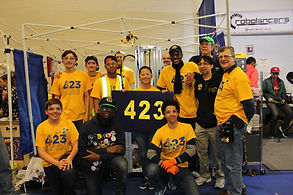
2017: FIRST Steamworks
Teams are required to shoot wiffle balls which represent fuel into a simulated boiler which transfers the generated steam into an airship in the middle of the field. Each alliance has one airship, which they pressurize with steam from the boiler and load with plastic gears from the field. At the end of the match, robots can climb and hang on team-supplied ropes (or standard ropes supplied by FIRST) attached to the airship for additional points.
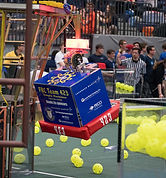
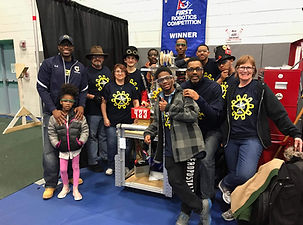
2016: FIRST Stronghold
FIRST STRONGHOLD is played on a 27 ft. by 54 ft. field. Each alliance commands one tower, five defenses, and a ‘secret passage’ which allows their robots to restock on ammunition, called boulders.
Each FIRST STRONGHOLD match begins with an autonomous period. During this period, robots attempt to cross opposing defenses and score in the opposing tower. During the remaining time of the match robots are controlled by student drivers from behind their castle wall at the end of the field. Teams on an alliance work together to cross defenses, weaken the opposing tower by scoring boulders in it, and finally surround, scale and capture the tower.
2015: Recycle Rush
RECYCLE RUSH is a recycling-themed game played by two Alliances of three robots each. Robots score points by stacking totes on scoring platforms, capping those stacks with recycling containers, and properly disposing of pool noodles, representing litter. In keeping with the recycling theme of the game, all game pieces used are reusable or recyclable by teams in their home locations or by FIRST at the end of the season.
Click Here for the Competition Video

2014: Aerial Assist
AERIAL ASSIST is played by two competing Alliances of three robots each on a flat 25’ x 54’ foot field, straddled by a truss suspended just over five feet above the floor. The objective is to score as many balls in goals as possible during a two (2)-minute and 30-second match. The more Alliances score their ball in their goals, and the more they work together to do it, the more points their Alliance receives.
Click Here for the Competition Video

2013: Ultimate Ascent
ULTIMATE ASCENT is played on a 27' x 54' field. There are two pyramids placed in the center of each half of the field. There are five scoring locations; four of the goals are located on the opposing alliance's wall and the fifth is part of the pyramid at that end of the field. Matches are two minutes and fifteen seconds long. In the first fifteen seconds robots follow a set of pre-programmed instructions. Drivers then control their robots, attempting to score discs into the goals at the opposite end of the field. The robots also can climb the pyramid at the end of the match to score additional points.
2012: Rebound Rumble
REBOUND RUMBLE is played on a 27 feet by 54 feet designed to mimic a basketball court. At each end is an array of basketball hoops.There is one low hoop, two middle hoops, and one high hoop. Across the field are placed three tilting bridges. The bridges at the edges are color-coded for each alliance, and the center bridge, called the Coopertition bridge, is available for both alliances. Throughout the match, teams can score points by scoring basketballs into hoops. At the end of the match, points are scored for balanced alliance bridges. Balancing the Coopertition bridge with a robot from each alliance earns each alliance Coopertition points toward their qualification seed and the Coopertition Award.
2011: Logo Motion
LOGO MOTION is played by alliances of three robots on a 27’ x 54’ field. They compete to hang as many inflated plastic shapes on their grids as they can during a match. The higher the teams hang their game pieces on their scoring grid, the more points their alliance receives. In the first 15 seconds, robots operate independently of driver inputs and hang Ubertubes to score extra points. For the rest of the match, drivers control robots and try to maximize their alliance score by hanging as many logo pieces as possible. Any logo piece hung on the same peg as an Ubertube receives double points. If teams assemble the logo pieces on their scoring grids to form the FIRST logo, the points for the entire row are doubled. The match ends with robots deploying minibots, small electro-mechanical assemblies that are independent of the host robot, onto vertical poles. The minibots race to the top of the pole to trigger a sensor and earn additional bonus points.
2010: Breakaway
BREAKAWAY is played with two alliances of three teams each compete on a 27' x 54' field with two "bumps" in the field that divide it into three zones. Goals are located at the corners of the field, and extend behind the alliance wall and adjacent to the player stations. Balls are kicked or herded into goals. After goals are scored, human players must pick up the balls and pass them to the center of the alliance station to be placed on a ball return rack, after which they will re-enter play at midfield. At the end of the match, bonus points are awarded for robots that cling onto either of the two towers in the center of the field. More bonus points are awarded if alliance robots can suspend themselves from the robot clinging onto the tower.
2009: Lunacy
LUNACY is played on a rectangular field that is 54' by 27'. This field is a material called 'Glasliner FRP' and is referred to as 'Regolith'. The regolith is designed so that the robots, which have special mandated wheels that cannot be modified, have reduced traction, mimicking the effect of low gravity that would be seen by a robot driving on the moon. The robots drag trailers behind them that correspond to the color of the alliance they are on. The goal of the game is to score as many of the game pieces in the opposing side's trailers as possible. Robots start out in front of the opposite alliances' human players. Empty cells can be handed to a robot by the "payload specialist" at the mid-field position known as the "outpost". The robot can deliver the Empty Cell to their human player on one of the corners in order to get a Super Cell, worth more points.
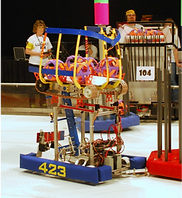
2008: FIRST Overdrive
OVERDRIVE is played on a 54' x 27' carpeted field, divided lengthwise by a fence median to create a track. The fence is crossed by an overpass marking the red and blue finish lines, and hold the game pieces: 40" diam. inflated balls called trackballs. Two three-team alliances race around the track in a counter clockwise direction while manipulating the trackballs to score points. Points are awarded every time a robot or trackball crosses their finish line and every time a trackball passes over the overpass. Additional points are awarded for each trackball that finishes on top of the overpass.


2007: Rack 'n Roll
RACK N' ROLL is played on a field dominated by 'The Rack', a large metal contraption with three levels of hanging metal bars, each being an octagon with 8 arms. Each arm has space for two game pieces. The goal for robots is to hang inner tubes of your alliance's color onto the arms of the Rack. Black inner tubes can be added on top of the opposing alliance's tubes to cancel them out. The primary method of scoring in Rack 'n Roll is by making rows and columns of your color tubes on the rack. A row or column of n tubes is worth 2^n points (max n=8). Each robot in its alliance's end zone at the end of the match that is elevated off the ground and not touching any field element will be awarded extra points.

2006: Aim High
AIM HIGH is played by two alliances, red and blue, each consisting of three robots. During a 10-second autonomous mode robots are programmed to score into any of the three goals: one raised center goal and two corner goals at floor level. At the end of the autonomous period the alliance with the most points will gain a bonus and will be placed on defense for round two. Rounds two, three and four are each 40 seconds long and are teleoperated rounds. Between rounds two and three the alliances switch from offense to defense or vice versa. At the start of round 4 any alliance can score into the corresponding goals. At the end of the match any alliance can receive bonus points by placing its three robots on a platform below the center goal.


2005: Triple Play
TRIPLE PLAY is played on a field set up like a tic-tac-toe board, with nine large goals, shaped like tetrahedrons in three rows of three. The primary game pieces were called "Tetras" which are 30" PVC tetrahedrons. The object of the game was to place the scoring tetras on the larger goals, creating rows of three by having a tetra of your alliance’s color at the highest point on the goal. Points were awarded for having your alliance's tetra on top of the goal, and bonuses for making rows of three.
*our team number was 487 back then

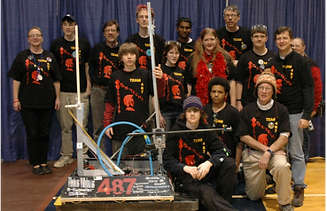
2004: FIRST Frenzy: Raising the Bar
FIRST Frenzy: Raising the Bar includes elements from previous years' games, including mobile goals, "capping" goals with large inflatable balls, and others. In FIRST Frenzy, teams could score by giving their human players purple balls and having them throw the balls into any goal, capping the goals with a large multiplier ball, or hanging their robot suspended from the 10' high 'chin up bar'.
Click here for competition video
*our team number was 487 back then
2003: Stack Attack
STACK ATTACK features two teams of two robots compete by moving large Sterilite bins into their zones and arranging them into stacks. Teams are awarded one point for every bin in their alliance's scoring zone the bins. This score is then multiplied by the height of their highest stack. Each robot on the top of the ramp at the end of the match adds 25 points to an alliance's score.
Click here for competition video
*our team number was 487 back then
2002: Zone Zeal
ZONE ZEAL is played on a field divided into fifths called zones. At the beginning of the match, there were 40 balls arranged along the sides of the field in the center zone and the two adjacent zones. In the center zone were three mobile goals.
The zones were numbered 1 through 5. The Blue team could score by placing ball-filled goals in zones 4 or 5, and could score a bonus 10 points for every goal in zone 4. At the end of the match, for every robot Blue had in zone 1, Blue would score 10 points. For the red alliance, it was the opposite. Balls could be scored in zones 1 or 2, goals would receive bonus points for being in zone 2, and robots scored 10 points each for ending the match in zone 5.
*our team number was 487 back then
2001: Diabolical Dynamics
DIABOLICAL DYNAMICS is played on a field divided in half by an 18 inch high railing with a central bridge, which can tilt to either side of the field or remain level. There are two 7 ft high movable goals in which teams place balls for points. Each match is a maximum of two minutes long. Alliances can end the match at any time. Alliances score one point for each small ball in the goal, ten points for each large ball in the goal, ten points for each robot in the End Zone, and ten points if the stretcher is in the End Zone. The alliance doubles its score for each goal that is on the bridge if the bridge is balanced, and multiplies its score by a factor of up to three by ending the match before the two minute time limit. Each team receives the alliance score. A team multiplies its score by 1.1 if its large ball is on top of a goal. Scores are rounded up to the nearest whole point after applying all multipliers.
*our team number was 487 back then
2000: Coopertition FIRST
COOPERTITION FIRST is played in carpeted, rectangular area with two 6 ft high goals located midfield, one goal for each alliance. Alliances receive one point for each yellow ball and five points for each black ball in their goal. There is a 2.5 ft clearance bar under each goal. Between the goals is a ramp with a 5 ft clearance bar, which robots may hang on to score points. At the end of the game, robots that are completely on the ramp earn five points for their alliance. A robot hanging from the horizontal bar connecting the two goals earns ten points for its alliance.
*our team number was 487 back then




